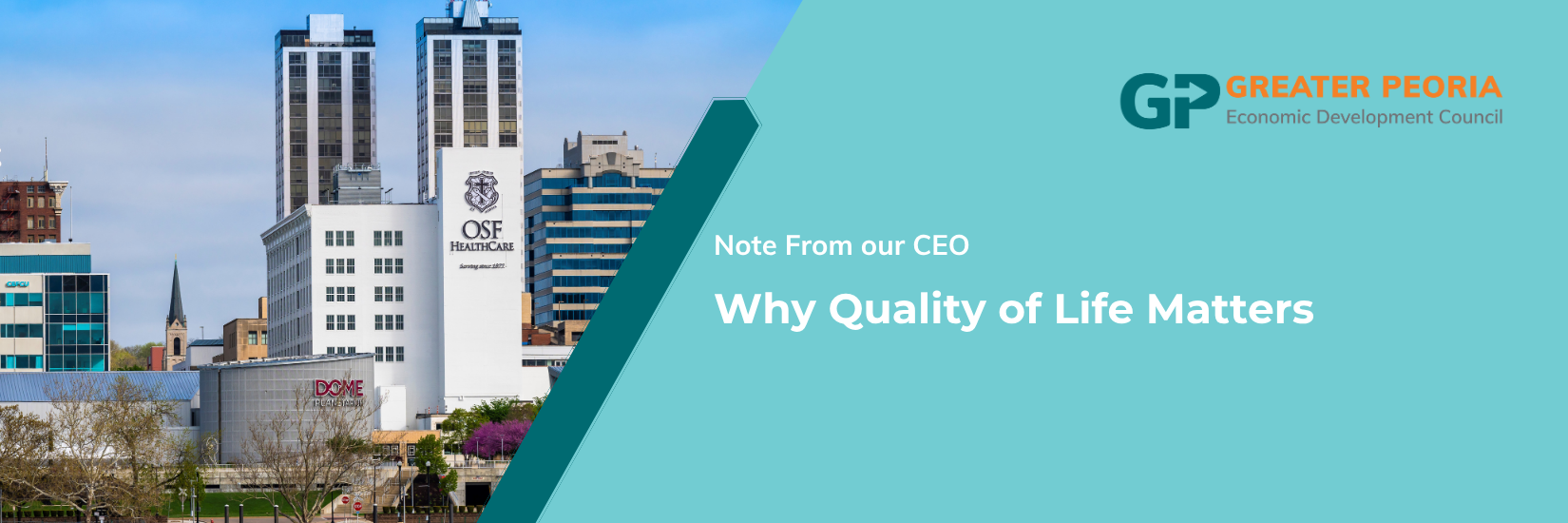In spite of the unseasonably hot and humid weather we and much of the country are experiencing here in late June, this is one of my favorite times of year in Greater Peoria. For me, it’s “golfing weather” but there are so many other things to do in our community. For me and my family, you can find us spending a part of our Saturday mornings at the Riverfront Market. We are season ticket holders to Peoria City Soccer and also love to catch Peoria Chiefs baseball games. If there is a band playing at CEFCU stage, there’s a pretty good chance my wife and I are there. And sometimes we just like to sit on our porch and talk to neighbors as they walk by. But the question is this: Does any of this matter when it comes to economic development?
Well, the answer is both yes and no. Let me take the no side first. Traditional economic development is a lot like the old saying about real estate: location, location, location. I’ve been involved in economic development for nearly 20 years now, and for the past 8 at GPEDC I’ve been pretty heavily involved in business attraction activities. At least in the preliminary stages of working with a business, most of the factors are what I’d call “hard considerations.” Do we have the right size site or do we have a building with the right dimensions? Can we leverage our great transportation assets like the river or our rail system? Are the utilities in place or do we have a plan to get them in place? Do we have a readily available workforce to meet employment demands? The fact that our community is a great place to live doesn’t really matter if we can’t meet the basic needs of a company.
While I haven’t had quality of life questions come up in those early discussions, if we make it to the “site visit” stage, Greater Peoria really impresses people. For Americans, we are sort of a hidden gem. They might have heard of Peoria, but are surprised at all we have to offer. Foreigners are usually even more impressed. They see our lack of congestion, river, skyline, affordable homes and greenery (sometimes a luxury in foreign cities) and can start to see themselves and their companies here. That was my experience in hosting a Brazilian delegation last summer. Many were from smaller cities in Brazil, and while the magnitude and magnificence of Chicago was impressive, they were pleasantly surprised by the “big city, small town” feel of our community. Let’s face it, we might have a lot of competition for rail-served properties and a good workforce, but it is harder to compete with the other things we have to offer.
But economic development is not just about business attraction. “Quality of life” impacts a range of important areas. Just like getting companies interested in our region is a key activity, we also need to be attracting talent. That’s why the Choose Greater Peoria initiative is so important. We are building a great pipeline of workforce development here, but we will always need “newcomers” to help fill jobs – particularly high skilled positions like surgeons and engineers. A great quality of life also helps retain talent and prevents the “brain drain” that plagues so many communities. Quality of life is even more important in the startup world. Communities with a high quality of life often boast a more vibrant and diverse social and cultural scene, which can foster creativity, collaboration, and a climate conducive to innovation and entrepreneurship.
People are also more likely to start businesses and invest in a place where they feel comfortable, safe, and have access to the resources and amenities that support their lifestyle. We want to build “sticky places.”
I’ve been in and around public service long enough to have heard, probably hundreds of times, people say “if you just have smooth roads, adequate public safety and good schools, the rest will take care of itself.” There is certainly some truth in that: Without those things, the rest can be immaterial. But I would challenge us to all focus on quality of life issues, too. We have it pretty good in our region, but there is always room for improvement. We need more vibrant downtowns and Main Streets, not just in Peoria but in all our villages, towns and cities. We need to be striving for the best school systems possible. We need great parks, active transportation options, walkable neighborhoods, and activities for youth and adults. We need to address our social problems and create an environment where all people, regardless of background, can thrive. And just as importantly, we all need to recognize the value our community has and share that message with the world. Quality of life matters, and while there is always more work to do, we have a lot to be proud of in Greater Peoria.
